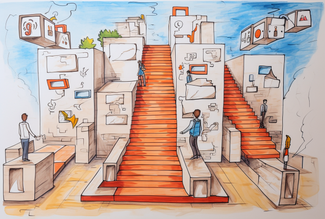
How to build trust in remote teams
We talk about trust in the context of personal relationships all the time. But have you ever thought about how trust feels? Do you feel it in your stomach? In your head? Or in your heart? This is a question too few leaders ask themselves.
I was just 17 when I first saw what trust does to people in the workplace. Working as a team leader in one of the biggest clothing stores in Europe, I realized that there was a connection between trust, well-being, and the team’s ability to work together. And what worked back then, also worked in the later stages of my career, as I went on to become a senior executive in a 4,000 person organization. I realized that trust was the foundation of psychological safety in the workplace. That, in turn, is the main driving force behind team performance, whether my team was made up of five Dutch teenagers or a hundred middle managers.
I’m happy to say that I wasn’t the only one to have come to this realization. In fact, over the past two decades, many organizations have made trust one of their core values. Then the pandemic hit, and leaders had to quickly reinvent themselves, and their trust in teams.
The role of trust in remote working
Not that long ago, the world got catapulted into a remote revolution. Business leaders were confronted with a new challenge; “How do I build trust in a remote work environment?”
It sounded easy at first, until many of them realized the old approach no longer worked. It was the same game, but with different rules. A bug slipped into the team code.
Instead of continuing to build and nurture trust like in the office days, the focus shifted. Leaders looked for ways to keep the team busy and aligned at all costs. Trust lost its position as a primary objective, with discipline becoming the core focus in driving performance remotely.
Moreover, the remote revolution didn’t only change the way we work. It also exposed organizations and leaders and the real trust inside the teams (which is something I talk about in my TEDx talk). People suddenly realized that the emperor had no clothes and felt compelled to leave. We now call this the Great Resignation.
And there was one major factor that contributed to it. A disease even. Micromanagement.
Micromanagement kills trust
Micromanagement kills trust in remote teams, and it comes disguised in many forms. Whether it’s monitoring software, endless meetings, or a plethora of online tools, it all takes autonomy away from people.
I’ve experienced how being micromanaged feels first-hand. It is like constant negative attention that gets paid in trust. And when the trust bank goes bust, the person either burns out or leaves the company.
As with most diseases, micromanagement has several symptoms (all perfectly treatable, by the way):
- Digital presenteeism. This describes a constant anxiety to be online and visible. A study from Qatalog and GitLab, found that 54% of employees feel pressure to show that they are online. As a result, workers spend an additional 67 minutes online each day, with 73% responding to notifications outside work hours. Digital presenteeism is seen as one of the main reasons for burnout among remote workers.
- A lack of initiative. When people feel a lack of trust, they’re less likely to take initiative. Proactivity becomes reactivity, which in turn makes leaders check in even more often. Reactivity kills playfulness in a job, and that spells bad news for well-being and engagement.
- Lack of creativity. A lack of trust increases stress, which triggers a fight-or-flight response. When someone is in this state, there’s not much activity in our right brain, where creativity lives. Instead, we’re on the lookout for that sabertooth tiger and thinking of ways to defend ourselves, rather than creating stuff and thinking outside the box.
There are more symptoms of course, but these three will be familiar to most people. Together, they can damage team morale, leading to high attrition rates and poor performance overall.
It doesn’t have to be this way.
I’ve spent 20 years leading teams. In that time, I’ve learned lots about how to build trust, most of which can still be applied to remote work. These can be broken down into three core aspects - Leadership, Purpose, and Workflow.
Related reading: How to set remote teams up for success
Leadership
I don’t think micromanagers are bad people who are obsessed with controlling people. I think they feel insecure and don’t necessarily know how to lead their teams remotely, so they resort to micromanagement. To help remedy this, leaders and managers need training in empathic skills, inclusion, remote communication, remote culture, and remote workflows. The rules of the game have changed, but some organizations still think they can carry on as normal and get away with it.
I’ve worked with dozens of leaders desperately trying to adapt to remote work and they were often just thrown in the deep end. In most cases they just need a helping hand to learn how to swim again.
Purpose
When you are working alone at your kitchen table, it can sometimes be difficult to know if your work has any meaningful impact. That’s why the best remote organizations are purpose-driven, as it helps people associate their work with something bigger.
To support this in a remote environment, leaders must articulate the core values, beliefs, and mission and vision statements of the company more often, and explain how people are contributing to it, as this keeps purpose alive.
It might not seem like a top priority for busy execs, but it should be, as it informs your culture and creates a strong foundation from which you can build trust.
Workflow
According to research from Qatalog and GitLab, 50% of knowledge workers say they are inundated with the number of tools they use, and 60% of them have no idea what their colleagues are doing. That to me, is a workflow problem.
Successful remote work is about processes. The smarter and leaner your tech stack is, the more it supports asynchronous work, which improves visibility and eliminates many micromanagement layers.
Working in this way changes the focus from time spent on the task, to delivery and outcomes. That’s why I love Qatalog. It is a powerful tool to streamline asynchronous workflows in a single, centralized system, giving back precious time to teams.
I’ve seen tremendous results in clients with the right tech stack and agreements on usage. However, the right digital tools are just one part of the equation. Teams must also put an effort into what we can do with tools, or more important, what the boundaries are.
Final words
“We had a golden chance to say goodbye to the rigid 9-5, but it appears we’re still stuck in old habits of presenteeism, and technology is making things worse.” I loved how Qatalog’s recent Killing Time study expressed this, but I strongly believe that the golden chance hasn’t disappeared quite yet.
But trust in remote organizations will make or break the future of remote work. That’s why it’s imperative for leaders to take it seriously.
I trust that remote work is here to stay, and so is the end of the 9-5. And coming back to my original question, for those wondering, I can feel that trust in my heart.
Book a call with our Customer Team to find out more about how Qatalog can help support an open source culture at your workplace.



